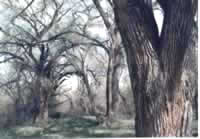NATURE HAPPENINGS - March 2001
by Damian Fagan
The Porky and The Tree
 The
tall cottonwoods stand bare, silhouetted against the canyon wall.
Branch tips are swollen with thick floral buds, the promise of future
generations. Leaves will not appear until the wind-borne pollen
has been spread.
The
tall cottonwoods stand bare, silhouetted against the canyon wall.
Branch tips are swollen with thick floral buds, the promise of future
generations. Leaves will not appear until the wind-borne pollen
has been spread.
 I
scan the trees in search of stick nests. I hope to locate old Cooper’s
or red-tailed hawk nests before the leaves cover them under a greenery
of secrecy. Though their presence does not indicate activity, it
does provide some potential territories to check later on. There
may even be long-eared or great homed owls using these sites, forcing
the previous owner to search elsewhere for a suitable nest site.
I
scan the trees in search of stick nests. I hope to locate old Cooper’s
or red-tailed hawk nests before the leaves cover them under a greenery
of secrecy. Though their presence does not indicate activity, it
does provide some potential territories to check later on. There
may even be long-eared or great homed owls using these sites, forcing
the previous owner to search elsewhere for a suitable nest site.
As I scan the trees with my binoculars, I notice some dark humps
scattered throughout the grove. I switch to my spotting scope to
zoom in on the shapes, some of which turn out to be mats of debris
from last year. Others turn out to be not birds but mammals, and
spiny ones at that.
 With
the help of the morning sun, I can see the yellow-tipped hairs set
amongst thickets of dark-looking spines. And there is only one North
American mammal with long, sharp quills - the common porcupine.
With
the help of the morning sun, I can see the yellow-tipped hairs set
amongst thickets of dark-looking spines. And there is only one North
American mammal with long, sharp quills - the common porcupine.
Asleep in the tree? Perhaps. Sometimes it is difficult to tell with
these slow moving creatures. They often spend the night in a tree,
propped up by their muscular tails to keep them from failing down.
Though the animals may den in a rocky alcove or other shelter, most
mornings find them ready to resume their feast of the day before.
Second in size only to the beaver, porcupines are large rodents.
Adults average 2 1/2 to 3 feet long and can weigh up to 35 pounds.
As I watch these sleepy individuals I am reminded of porcupines
feeding in cottonwoods trees in Lathrop Canyon one autumn evening.
The noise of their chewing could be heard a 100 yards away.
 Porcupines
are common in woody or brushy habitats, often occurring in riparian
or pinyon woodlands. Trees provide food, shelter and escape; finding
a porcupine in the grassy Cisco Desert would be an anomaly. In trees,
porcupines feed on the buds, twigs and inner bark. Winter finds
them dining on the tree’s outer bark, often partially girdling
a tree in order to consume enough food. Sometimes, due to the preference
for salt, porcupines may be observed chewing on hiking boots, old
outhouse walls or some other salt-encrusted item.
Porcupines
are common in woody or brushy habitats, often occurring in riparian
or pinyon woodlands. Trees provide food, shelter and escape; finding
a porcupine in the grassy Cisco Desert would be an anomaly. In trees,
porcupines feed on the buds, twigs and inner bark. Winter finds
them dining on the tree’s outer bark, often partially girdling
a tree in order to consume enough food. Sometimes, due to the preference
for salt, porcupines may be observed chewing on hiking boots, old
outhouse walls or some other salt-encrusted item.
Though guarded by a thick coat of long, hollow quills, the porcupine
is not immune to predation. Mountain lions and bobcats may prey
upon porcupines, but first the predator must flip the porcupine
on its back to get at the soft, unprotected  underbelly.
Though it seems that domestic dogs are the only ones to get a snout-full
of quills, young coyotes may also manage to learn a sharp lesson
from the porcupine. But built into the tips of the quills are antiseptic
properties that minimize the chance of infection should a porcupine
somehow suffer from self-inflicted wounds.
underbelly.
Though it seems that domestic dogs are the only ones to get a snout-full
of quills, young coyotes may also manage to learn a sharp lesson
from the porcupine. But built into the tips of the quills are antiseptic
properties that minimize the chance of infection should a porcupine
somehow suffer from self-inflicted wounds.
I leave my observation post and wander over to the grove of cottonwoods
searching the ground for the distinctive tracks of the porcupine.
I find them in some soft sand, the pebbled soles separated by the
tail drag. It appears as if someone followed behind, sweeping the
sand in a gentle S-pattern with a stiff bristled broom. The tracks
lead me to the tree in which one now perches, dreaming, no doubt,
of the promise of delectable greenery in the near future.
© 2001 Moab Happenings. All rights
reserved. Reproduction of information contained in this site is
expressly prohibited.